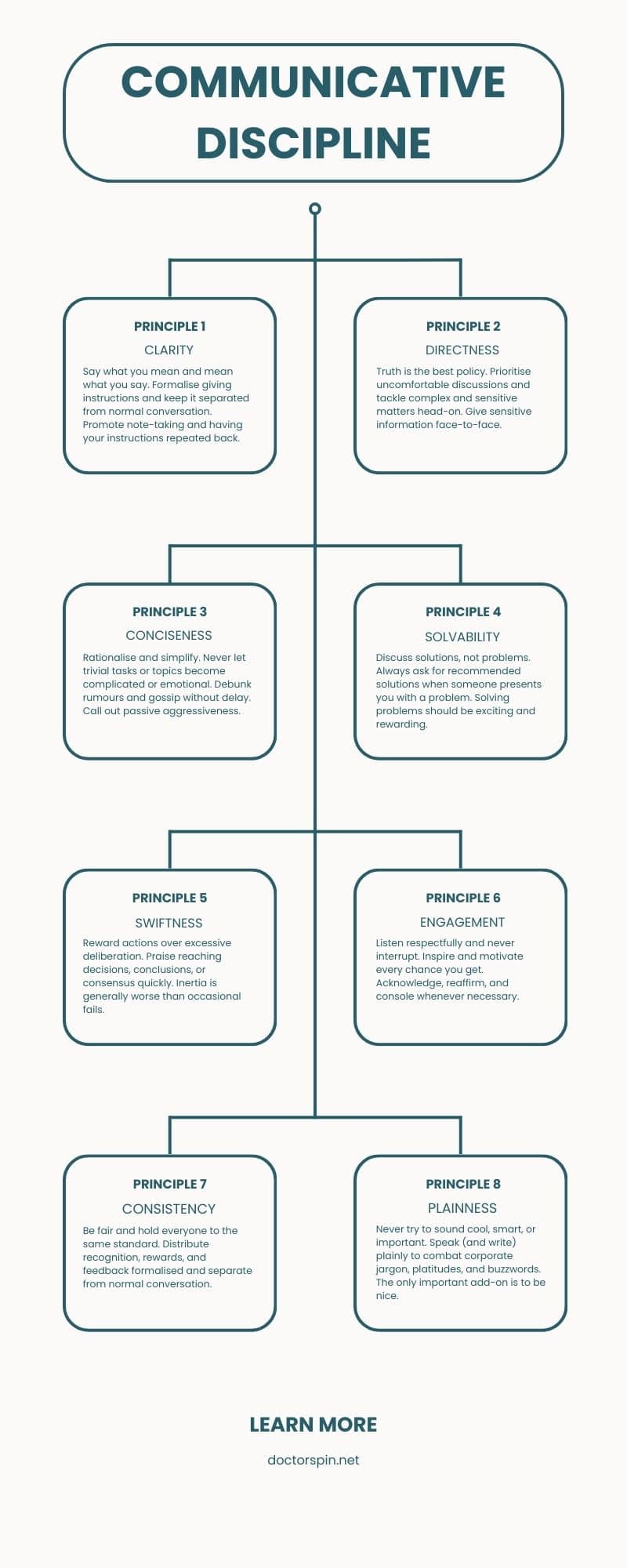I use Split Sessions for recognition, rewards, and feedback.
Positive reinforcement is critical in fostering an open and transparent internal communications culture.
This blog post highlights the importance of separating recognition, rewards, and feedback in communicative leadership and provides a framework with rules for effective implementation.
Here we go:
The Split Sessions Framework
Recognition (praise), rewards, and feedback are powerful reinforcement tools for communicative leaders. They are also fundamental for improving internal communication and fostering a corporate culture of openness and dialogue. 1Silfwer, J. (2024, November 13). The Ritual of Giving Instructions | Communicative Leadership. Doctor Spin | The PR Blog. https://doctorspin.net/giving-instructions/
Key takeaway: Strive to separate different types of interactions (feedback, praise, orders/instructions, rewards, etc.) to prevent confusion and anxiety within your team. 2Silfwer, J. (2023, December 30). Split Sessions: Recognition, Rewards, and Feedback. Doctor Spin | The PR Blog. https://doctorspin.net/split-sessions/
The challenge for any leader is a) to keep such sessions separate and b) to maintain constant levels over time.
Recognition (Praise)
Recognition = acknowledging (praising) the contributions of a team member.
Rewards
Reward = incentivising a team member to produce results that exceed expectations.
Feedback
Feedback = letting a team member know if the work has the intended effect.
The Split Sessions Framework underscores the importance of separating praise, rewards, and feedback in communicative leadership.
Learn more: Split Sessions: Recognition, Rewards, and Feedback
Communicative Leadership is Critical
In leadership, the way messages are conveyed is just as important as the messages themselves.
“Leaders’ communication styles, particularly preciseness, are crucial for effective knowledge sharing, perceived leader performance, and subordinate satisfaction.”
Source: Journal of Business and Psychology 3Vries, R., Bakker-Pieper, A., & Oostenveld, W. (2009). Leadership = Communication? The Relations of Leaders’ Communication Styles with Leadership Styles, Knowledge Sharing and Leadership … Continue reading
Effective communication is a cornerstone of success in leadership and management, particularly in how leaders deliver praise, rewards, and feedback.
A well-thought-through approach enhances communication clarity and builds trust and respect within the team. As a leader, your choice and delivery of words are instrumental in shaping your team’s culture and performance. Leaders can foster a more positive and productive work environment through clarity and consistency.
“Formative feedback should be non-evaluative, supportive, timely, and specific to improve learning and should be tailored to individual learner characteristics and task aspects.”
Source: Review of Educational Research 4Shute, V. (2008). Focus on Formative Feedback. Review of Educational Research, 78, 153 – 189. https://doi.org/10.3102/0034654307313795
Avoiding Cultural Uncertainty
Research supports the idea that leaders should give feedback and provide praise on separate occasions. According to research by O.C. Tanner, highlighted in a SmartBrief article, 42% of employees who received recognition from their leaders also received a message of “here’s how you can do better” in the same communication. 5Miller, J. V. (2018, October 9). Here’s why you need to separate praise from feedback. SmartBrief. https://corp.smartbrief.com/original/2018/10/heres-why-you-need-separate-praise-feedback
Combining recognition, rewards, and feedback tends to send mixed messages, leaving employees uncertain about cultural conduct. This suggests that separating recognition from rewards and feedback is crucial in ensuring both are received as intended without undermining the effectiveness of either.
When instructions, feedback, and recognition are intertwined, their impact is diluted. Employees may begin to question the sincerity of the praise or feel that every compliment has a catch.
Communicative Discipline
For corporate communications in general, and communicative leadership in particular, I recommend a direct approach to intrapersonal communication:
As a PR advisor, I refer to these principles as communicative discipline. 6Silfwer, J. (2023, December 24). Parkinson’s Law & The Law of Triviality (Bike Shed Effect). Doctor Spin | The PR Blog. https://doctorspin.net/parkinsons-law/
Learn more: Principles for Communicative Discipline

THANKS FOR READING.
Need PR help? Hire me here.

PR Resource: Communicative Leadership
Spin Academy | Online PR Courses

Spin’s PR School: Free Leadership PR Course
Take advantage of this Free Leadership PR Course to sharpen your public relations skills and become a confident and influential leader in any industry.
Leadership Theory
Communicative Leadership
Bonus Articles
Learn more: All Free PR Courses
💡 Subscribe and get a free ebook on how to get better PR.

Annotations
| 1 | Silfwer, J. (2024, November 13). The Ritual of Giving Instructions | Communicative Leadership. Doctor Spin | The PR Blog. https://doctorspin.net/giving-instructions/ |
|---|---|
| 2 | Silfwer, J. (2023, December 30). Split Sessions: Recognition, Rewards, and Feedback. Doctor Spin | The PR Blog. https://doctorspin.net/split-sessions/ |
| 3 | Vries, R., Bakker-Pieper, A., & Oostenveld, W. (2009). Leadership = Communication? The Relations of Leaders’ Communication Styles with Leadership Styles, Knowledge Sharing and Leadership Outcomes. Journal of Business and Psychology, 25, 367 — 380. https://doi.org/10.1007/s10869-009‑9140‑2 |
| 4 | Shute, V. (2008). Focus on Formative Feedback. Review of Educational Research, 78, 153 – 189. https://doi.org/10.3102/0034654307313795 |
| 5 | Miller, J. V. (2018, October 9). Here’s why you need to separate praise from feedback. SmartBrief. https://corp.smartbrief.com/original/2018/10/heres-why-you-need-separate-praise-feedback |
| 6 | Silfwer, J. (2023, December 24). Parkinson’s Law & The Law of Triviality (Bike Shed Effect). Doctor Spin | The PR Blog. https://doctorspin.net/parkinsons-law/ |
| 7 | Silfwer, J. (2023, December 30). Split Sessions: Recognition, Rewards, and Feedback. Doctor Spin | The PR Blog. https://doctorspin.net/split-sessions/ |
| 8 | Silfwer, J. (2020, May 23). Corporate Cringe. Doctor Spin | The PR Blog. https://doctorspin.net/corporate-cringe/ |
| 9 | Silfwer, J. (2015, October 9). The Platitude Sickness: The Trash of Corporate Writing. Doctor Spin | The PR Blog. https://doctorspin.net/platitude-sickness/ |



